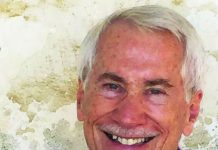
“I’m not talking about the way it was, just the way it’s never gonna be again.”
That’s the subtitle of local author Craig Lockwood’s delightful book “Peanuts,” a biography of Laguna’s famed early big wave surfer, George “Peanuts” Larson. Those were the days (the 50s) when giant bugs (lobster) were legal to take and in easy reach, as well as abalone, which were pounded, tenderized, and shared on the beach with friends. Of course we will never return to those days because of our voracious appetite to consume everything not nailed down.
But to know these stories and the wonderful characters in them is to understand the unique provenance of Laguna. And to preserve and steward the historic early California architecture is not only our right, it’s our civic responsibility.
That responsibility falls on the Design Review Board to ensure that homes are not overbuilt, and remain compatible with the neighborhood. And that’s scary indeed, because the City Council recently reformed it, placing three real estate professionals on the board. That’s a majority, and to be clear, real estate brokerage is a commission-based business. The bigger the home, the more they make. So it brings into question whether they can be truly objective, because preservation is often antithetical to home sales. So should our three board members recuse themselves from any decision that directly begets a listing?
Case in point: my neighborhood in Temple Hills had to recently appeal the DRB approval of a 6,000-square-foot, seven-bath spec home on a vacant lot at the top of Bluebird Canyon, with another 2,000 square feet of deck and garage space. It’s a massive imposition on Rimrock Canyon, but a tasty commission for a listing agent.
The developer was clever enough to site it down the slope, so view and compatibility impacts would be hidden from the immediate neighbors. But boy oh boy it impacts my neighbors, eviscerating the hill in their view corridor, dropping four stories down the virgin escarpment, spreading 120 feet in width, and removing 16,495 cubic feet of earth with caissons sunken into sandy, unstable soil (that is buttressed by landfill placed after a previous landslide). That’s 123,391 gallons of dirt that nourishes the flora, fauna, and stabilizes the hillside. Just another non-local profiteer who would be gone in a couple of years, leaving a permanent scar and less habitat for our dwindling wildlife.
How did DRB miss the outsized incongruity to the neighboring homes that average 2,500 square feet? Or the expansive use of glass that meant the dark canyon we so enjoy would be lit up at night, and the stars obliterated? Or the long history of landslides in the area? This is where it helps to be local, and understand historical contexts of neighborhoods and their geology. Only longtime board member Debbie Neev recognized the property was not in compliance with the General Plan because of “width, mass, scale, and visual impacts to the canyon.”
Most of the families living in my neighborhood have been here for 30 to 40 years and have savored the special magic of this dark canyon. It’s a real community of long-term, naturalized locals – working class folks who were able to raise families here. And what binds us so magnificently is a shared love of the towering trees, the cascading canyon, the peacefulness, and the country feel in the heart of town. Not to mention the human-scaled homes. It would be tragic to defile the canyon.
But sometimes there are indeed miracles. In a somewhat unprecedented, unanimous decision, City Council upheld the appeal and sent the developer back to Design Review. A rare rebuke. And with that, these five councilmembers, all born elsewhere, earned their “locals” stripes. And put the newly reformed Design Review Board on notice that, while residents, they have much to learn about being local.
Billy will interview Congressman Harley Rouda live at the Promenade on Forest Avenue at 12 p.m. on Sept. 6 on KX FM Radio. The public is invited.





I’d like to make a correction: One other Design Review Board member voted against the approval of this house: Louis Weil. It was a 3-2 vote. I did not mean to imply that all Realtors on the DRB support large homes that are incompatible with their neighborhoods. I’m simply advocating that they carefully review each home to make sure they adhere to the General Plan – even if it’s the 2nd or 3rd review – and the applicant had already made significant reductions, like this one did.